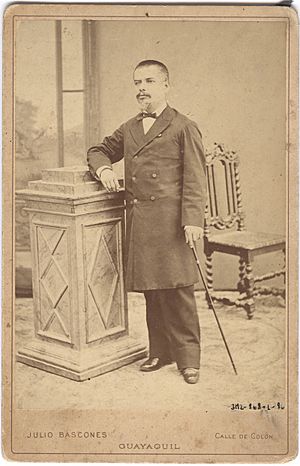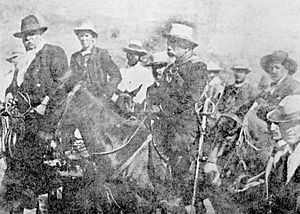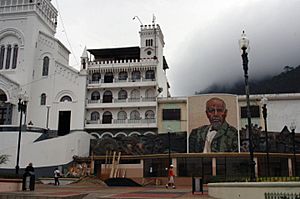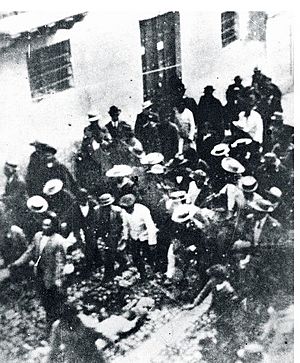Eloy Alfaro facts for kids
Quick facts for kids
José Eloy Alfaro Delgado
|
|
|---|---|
 |
|
| 15th President of Ecuador | |
| In office 16 January 1906 – 12 August 1911 |
|
| Preceded by | Lizardo García |
| Succeeded by | Carlos Freile Zaldumbide |
| In office 5 June 1895 – 31 August 1901 |
|
| Vice President | Manuel Benigno Cueva (1897—1899) Carlos Freire Zaldumbide (1899—1901) |
| Preceded by | Vicente Lucio Salazar |
| Succeeded by | Leónidas Plaza |
| Supreme Chief of Manabí & Esmeraldas, in rebellion | |
| In office February 1883 – 11 October 1883 |
|
| Personal details | |
| Born |
José Eloy Alfaro Delgado
25 June 1842 Montecristi, Ecuador |
| Died | 28 January 1912 (aged 69) Quito, Ecuador |
| Political party | Ecuadorian Radical Liberal Party (Founder) |
| Spouse |
Ana Paredes Arosemena
(m. 1872) |
| Signature | |
José Eloy Alfaro Delgado (born June 25, 1842 – died January 28, 1912) was an important leader and former President of Ecuador. People often called him "The Old Warrior" (or "Viejo Luchador" in Spanish). He was a strong leader of the Liberal Party and worked hard to bring fairness, justice, and freedom to his country. Eloy Alfaro was a major opponent of the pro-Catholic conservative President Gabriel García Moreno. Alfaro played a key role in the Liberal Revolution of 1895 and fought against old ways for almost 30 years.
Alfaro's main achievements include making Ecuador more united and protecting its borders. He also helped make the country more secular, meaning the government and church had separate roles. Alfaro modernized Ecuadorian society by introducing new ideas, improving education, and building better transportation and communication systems. His most famous project was the Transandino Railway, a huge engineering feat that connected the cities of Guayaquil and Quito. Today, Alfaro's image is on the Ecuadorian 50-cent coin, and the Ecuadorian Army's military college is named after him. Two ships of the Ecuadorian Navy also bear his name.
Contents
Biography
Early Life and Rebellions
Eloy Alfaro was born in Montecristi, in the Manabí Province, on June 25, 1842. His father, Manuel Alfaro y González, was a Spanish Republican who came to Ecuador as a political exile. His mother was María Natividad Delgado López.
Alfaro finished his primary education in his hometown. Afterward, he helped his father with business. From a young age, he supported liberal ideas that were against the strong influence of the Catholic Church in government. These ideas later formed the Ecuadorian Radical Liberal Party. He fought against several presidents, which is why he is known as "The Old Warrior." Eloy Alfaro faced many challenges in his campaigns against the conservative governments of Ecuador. He used his own money, earned with the help of his Panamanian wife, Ana Paredes Arosemena, to fund these battles. They had nine children together: Bolívar, Esmeraldas, Colombia, Colón, Bolívar (the second), Ana María, América, Olmedo, and Colón Eloy.
Alfaro started participating in rebellions very early in his life. He almost died in a naval battle when his ship sank while trying to land in Ecuador with revolutionary troops. He saved himself by clinging to a barrel. He took part in many important battles, including those in Montecristi, San Mateo, Esmeraldas, Guayaquil, Jaramijó, Gatazo, Cuenca, and Chasqui.
Alfaro was a good father and was generous to his friends and those in need. He supported many liberal thinkers, like the writer Juan Montalvo, by offering him money. When Alfaro became president, he honored Montalvo as a great teacher and an example for the Ecuadorian people. Even though Alfaro did not have a lot of formal education, his strong character and clear intelligence impressed everyone. During his time in exile, he traveled through Central America and was given the rank of "General de División" by the Nicaraguan Congress.
First Presidency (1895–1901)
As the leader of the Radical Liberals, Alfaro led the Liberal Revolution of 1895. This was a struggle he had been fighting since the 1860s. In 1895, the liberals finally took power in a coup d'état. He removed President Vicente Lucio Salazar from office and declared himself a dictator on June 5, 1895. Later, he was officially named constitutional president and served from January 17, 1897, to September 1, 1901.
The most important achievement of his first government was introducing the idea of secularism. This meant separating the government from the influence of the church. Many public buildings in Quito, like the Instituto Nacional Mejía and the first main building of the National Polytechnic School, were built during his time as president. French architects designed these buildings.
Second Presidency (1906–1911)
After his first term, Alfaro initially supported his successor, but later disagreed with him. In 1906, he led another revolt, removing elected President Lizardo García. The army then declared him supreme dictator, and he remained in office until August 12, 1911. During this second presidency, he made many important changes. These included freedom of speech and making civil marriage and divorce legal. He also built many public schools and established the right to a free and secular education for everyone.
His greatest public work during this time was completing the Ferrocarril Transandino (Trans-Andean Railroad). This railway connected Guayaquil to Quito, which was a huge achievement for the country. Because he believed in separating church and state, he reduced the influence of the Catholic Church while in office. He took control of much of the Church's property, sent religious orders out of the country, and stopped new monasteries or convents from being built. The Archbishop of Quito, Federico González Suárez, opposed his efforts to make Ecuadorian society more secular.
In 1911, his former supporters removed him from office. He tried to regain power later that year but was captured near Guayaquil and sent to Quito on the very railroad he had built. After he left office, during the government of Emilio Estrada Carmona, Alfaro strongly criticized the government. His followers soon started organizing military uprisings. Alfaro was sent away to Panama during the temporary government of Carlos Freile Zaldumbide. He returned to Ecuador on January 4, 1912, and tried another coup. However, he was defeated, arrested, and jailed by General Leónidas Plaza.
Assassination and Legacy
On January 28, 1912, a group of soldiers, supported by a crowd, broke into the prison where Alfaro and his friends were held. They were taken through the streets of the city. By the time they reached the area of El Ejido (city gardens) in the northern part of town, they were all dead. The crowd then burned their bodies in the area where El Ejido park is today. A monument was built there in the 1960s to remember them. Days later, Alfaro's remains were secretly buried in Quito. They were later moved to a mausoleum in Guayaquil in the 1940s. In 2007, President Rafael Correa arranged for some of Eloy Alfaro's ashes to be moved and re-buried with honors in Montecristi, the city where he was born. This was also where the 2008 National Constitutional Convention was held.
See also
 In Spanish: Eloy Alfaro para niños
In Spanish: Eloy Alfaro para niños





